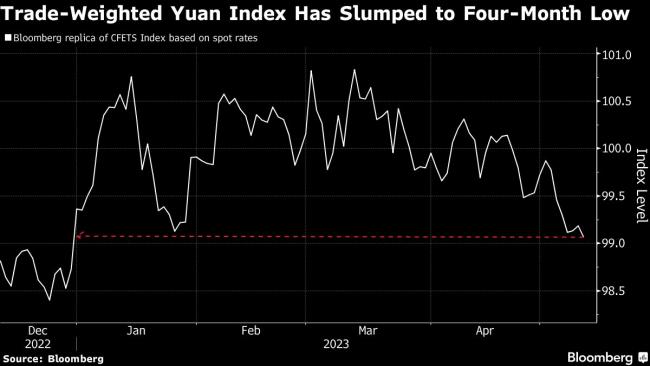Yuan Primed for Losses on Uneven Recovery, Political Tensions
2023.05.11 05:49

(Bloomberg) — China’s yuan has held its own against the dollar in recent weeks but that’s only masking a broader depreciation that may be set to accelerate.
The currency this week slid to the lowest level in more than four months versus a currency basket of its major-trading partners, according to a Bloomberg replica of the official CFETS index. Indeed, the yuan has only been resilient against the dollar because the greenback itself is coming under pressure on signs US interest rates are topping out.
The yuan basket is likely to fall further as the currency usually underperforms its Asian peers during period of dollar weakness, said Stephen Chiu, chief Asia foreign-exchange and rates strategist at Bloomberg Intelligence in Hong Kong.
The yuan also tends to be relatively weak this time of year due to dividend outflows, while the resumption of outbound tourism, lingering geopolitical tensions, and the waning of reopening optimism are also headwinds, he said.
Examples of the broader decline of the yuan can be seen in a number of crosses. The currency last month slid to the weakest since August 2021 versus the euro,while this week its slipped to the lowest since October 2021 against the pound, and earlier this month touched the weakest since September against Indonesia’s rupiah.
Another reason for the yuan’s underperformance is the widening divergence between China and the US yields. The yuan’s three-month interbank rate is currently 2.36%, nearly 300 basis points below the comparable US dollar London interbank offered rate at 5.34%, the largest gap on record. That’s convincing exporters and banks to hold on to their dollar deposits to get higher yields.
Economic data in recent weeks have cast doubts on China’s re-opening optimism that was expected to bolster demand for the nation’s assets. In April alone, export growth slowed, manufacturing unexpectedly contracted, and the services sector expanded less than analysts forecast.
At the same time, geopolitical risks continue to build. The US is set to place more restrictions limiting investments on key parts of the Chinese economy such as semiconductors and artificial intelligence later this month, while China has also become involved in another diplomatic dispute with Canada.
Funds Sell
Overseas investors turned net sellers of Chinese stocks for the first time since October last month, and outflows from the nation’s sovereign bonds rose to a record last quarter, according to data compiled by Bloomberg.
“Lately markets have been viewing China’s economic data through a pretty bearish lens, and there’s still enough political risk premium to keep markets biased bearishly and to keep investor participation pretty low,” said Galvin Chia, a currency strategist at Natwest Markets in Singapore.
The CFETS Index, which tracks the yuan against a basket of 24 of the currencies of its main trading partners, slipped to 99.27 last Friday, the lowest level since December. from as high as 100.53 in mid-February.
The index is likely to extend declines to 94 to 95, Citigroup Inc (NYSE:). strategists led by Dirk Willer wrote in a research note this month, citing possible widening of services deficit and capital outflows.
Muted Inflation
The yuan’s broader weakness may be most visible against those currencies that are being buoyed by still-rapid inflation or are likely to be boosted by additional central bank interest-rate increases, such as the euro and the pound, according to strategists at Australia & New Zealand Banking Group (OTC:) Ltd.
The euro-yuan and pound-yuan pairs may rise further due to China’s muted inflation and easing bias, ANZ strategists Irene Cheung and Brian Martin, wrote in a note. They may also gain as Chinese authorities urge banks to lower their deposit rates, at least until China’s economic recovery gains further traction and sentiment improves, they said.
©2023 Bloomberg L.P.








